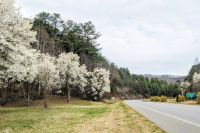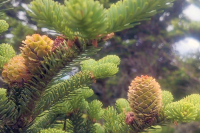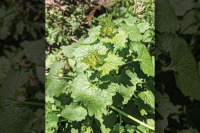150 and counting: WCU grad student research helps get a handle on impacts of mounting numbers of elk
 By Jill Ingram • Guest writer, WCU public affairs office
By Jill Ingram • Guest writer, WCU public affairs office
Covering long distances in and around Cataloochee Valley, a Western Carolina University student is researching the growing, and sometimes problematic, elk population in the Great Smoky Mountains National Park. The goal is to provide park rangers with data to help manage the herd.
Elizabeth Hillard, a 30-year old graduate student in biology, has gone to great lengths to find out whatever she could about the creatures.
Over the past year, Hillard located, hiked and mapped nearly 80 miles of elk trails. To study their eating preferences, Hillard even collected elk scat, which she froze in storage for later analysis. In all she has covered approximately 50 square miles of the park, with the sole purpose of documenting the daily habits of one of the park’s largest tourist attractions.
Hillard’s research was even awarded an $11,000 grant from the Rocky Mountain Elk Foundation this past fall.
Soon she will organize the information she has collected and draw conclusions about the elks’ habits in the wild, including what they eat, where they find shelter and their density as a herd throughout the area.
Related Items
Having a detailed account of everyday elk life may help the park avert disaster, as a result of an uncontrollable elk population. Already neighbors of the park have had run-ins and voiced complaints about the giant beasts causing problems on private property.
“We know that elk populations can swell to unnatural levels that have a negative impact on the environment,” said Joe Yarkovich, a park wildlife biologist who focuses on the elk program and who helped guide Hillard’s research.
At Rocky Mountain National Park, for instance, where the elk have no natural predators, the growing herds have destroyed aspen groves and willow stands, Yarkovich said.
“We’re trying to get on the front end of it so that we will see those impacts before they take effect and cause much harm to the environment,” he said.
The release of elk into the park began in February 2001 with 25 elk imported from Land Between the Lakes National Recreation Area along the Tennessee-Kentucky border. In 2002, another 27 elk were imported from Elk Island National Park in Alberta, Canada. All were released in the Cataloochee area, where many have stayed, though some have migrated west to Cades Cove — the animals like the open grassy areas at both of those locations, Hillard said.
The exact number of elk in the region is unknown, although a rough estimate puts the population at 150 animals, including those that have traveled outside the park boundaries, according to Yarkovich. Some elk wear radio-collars and are monitored so biologists can learn more about their movements and life spans, yet many do not and tracking their whereabouts can be more time-consuming.
And, as the elk population continues to grow, not only will information from research like Hillard’s be useful to understanding the elk, but also provide a baseline to monitor the dynamic relationship between the park and its herd.
“Five years from now, somebody will come back and do it again so we can track changes over longer periods of time, and I’ll hand them this packet and say, ‘This is what needs to be done,’ and it will be what [Hillard] has done for us. She really is setting it up long term,” Yarkovich said.
But Hillard’s research on diet and habitat is just one piece of the puzzle. Study in other areas such as herd health, dispersal patterns, disease monitoring are needed to better comprehend the elk.
“We’re trying to get a big picture for everything that’s going on regarding carrying capacity for elk in the Smokies,” Yarkovich said.
After she draws conclusions from a mountain of data, Hillard plans to complete her thesis and graduate in time to enter a doctoral program in wildlife ecology and management in the fall.
The Great Smoky Mountains National Park offers fertile ground for WCU students looking for masters and thesis research topics, according to WCU biology professor Laura DeWald. One of DeWald’s other students is currently working on a fire ecology project in the Smokies, for example. Others have engaged with the U.S. Forest Service or the N.C. Wildlife Resources Commission.
Such arrangements are mutually beneficial, affording students the opportunity to apply their education in the field and giving strapped agencies high-quality work for minimal financial investment.
“Agencies are having to do more with less. This work in the park needed to be done,” DeWald said. “Our students are involved in acquiring knowledge that can be used to inform resource management decisions.”













